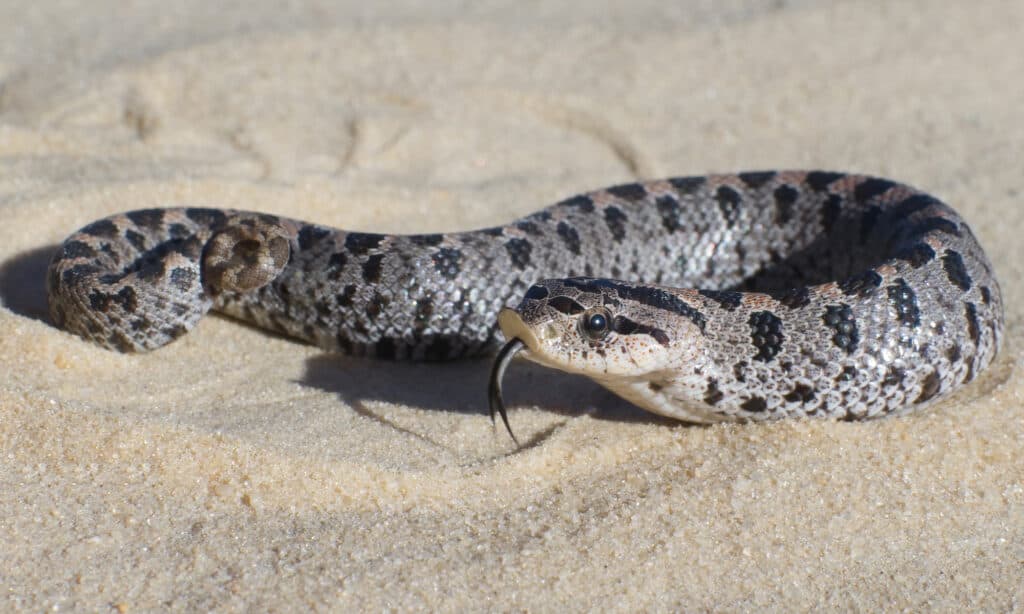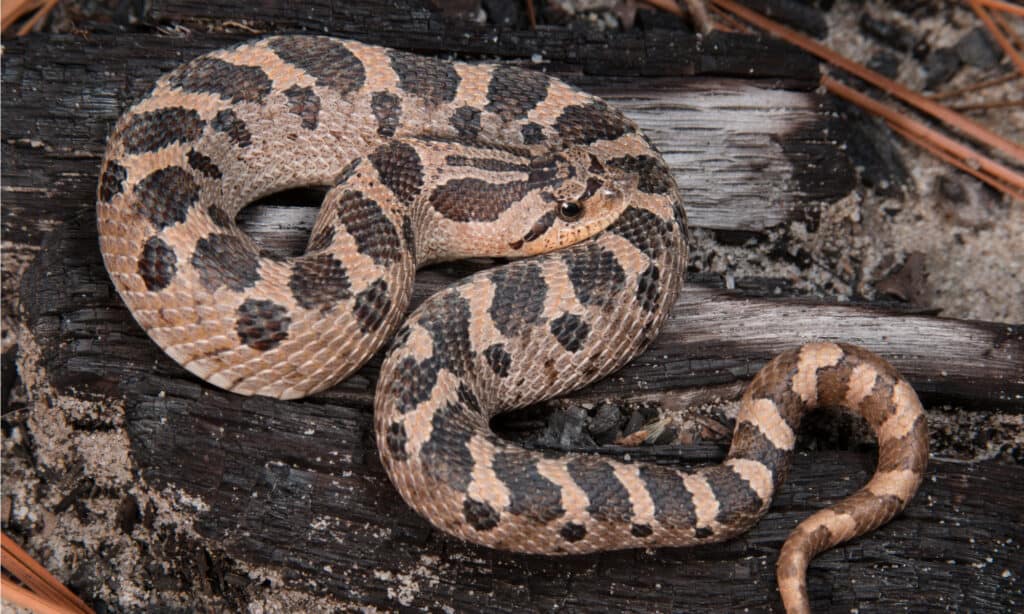Southern Hognose Snake
.jumbotron {
background-image: url(“https://a-z-animals.com/media/2022/04/Hognose-Snake-Southern-400×300.jpg”);
}
}
@media only screen and (min-width: 641px) and (max-width: 920px) {
.jumbotron {
background-image: url(“https://a-z-animals.com/media/2022/04/Hognose-Snake-Southern-470×370.jpg”);
}
}
@media only screen and (min-width: 921px) {
.jumbotron {
background-image: url(“https://a-z-animals.com/media/2022/04/Hognose-Snake-Southern.jpg”);
}
}
Southern Hognose Snake
Heterodon simus
The southern hognose snake has an upturned snout that enables it to dig through the soil.
Southern Hognose Snake Scientific Classification
- Kingdom
- Animalia
- Phylum
- Chordata
- Class
- Reptilia
- Order
- Squamata
- Family
- Colubridae
- Genus
- Heterodon
- Scientific Name
- Heterodon simus
Read our Complete Guide to Classification of Animals.
Southern Hognose Snake Conservation Status
Southern Hognose Snake Facts
- Prey
- Toads, snakes, and lizards
- Fun Fact
- The southern hognose snake has an upturned snout that enables it to dig through the soil.
- Litter Size
- 6-14 eggs
This post may contain affiliate links to our partners like Chewy, Amazon, and others. Purchasing through these helps us further the A-Z Animals mission to educate about the world’s species..

Discover alligator-eating snakes, spiders larger than your phone, and 1000 more incredible animals in our daily FREE email.
.photo-gallery {
–margin: 0px auto 0px;
–padding: 0px 0px 0px 0px;
}
.gallery-link {
background-image: url(“https://a-z-animals.com/media/2022/04/Hognose-Snake-Southern-1024×614.jpg”);
background-repeat: no-repeat;
background-size: cover;
background-position: center;
height: 500px;
justify-content: center;
text-align: center;
align-items: center;
display: flex;
border: 2px solid #000;
}
.gallery-link img {
height: 50%;
}
@media only screen and (max-width: 768px) {
.gallery-link {
height: 300px !important;
}
}
View all of the Southern Hognose Snake images!
The southern hognose snake has an upturned snout that enables it to dig through the soil.
Despite the ability to produce mild toxins, the southern hognose snake is almost completely harmless to people. When threatened, it has a tendency to display some dramatic behavior. It will try to hiss and puff up its body, and if that fails, it may start playing dead. For this reason, many people also call it a puff adder, but it is not related to the actual puff adders at all.
4 Southern Hognose Snake Amazing Facts
- During the reproductive season, male hognose snakes perform a kind of slithering dance to compete for and attract a mate. Females have been known to have multiple mates per season.
- After mating, the female hognose will lay six to 14 eggs within the sandy soil or underneath logs at some point in the early summer. The eggs will hatch in September or October. The baby hognose snakes use their specialized tooth to break through the surface of the egg. They do not receive any additional care from their family.
- Like many other members of the snake order, the hognose snake has the acute ability to pick up scents by flicking its tongue in the air and pressing the odor molecules against an organ located on the roof of the mouth. This organ has a direct connection to the brain.
- This species is preyed upon by king snakes, indigo snakes, red-tailed hawks, and other carnivorous animals. Eggs and baby hognose are even known to be preyed upon by fire ants.
Where to Find Southern Hognose Snakes
The southern hognose snake has historically been found across the coastal plains of the southeastern United States, from North Carolina down to Florida. Some of their preferred ecosystems include sandhills, pine flatwoods, and coastal dunes. They spend a great deal of their time hiding underground from potential predators.
button.pulse {
transform: scale(1); animation: pulse 2s infinite;
box-shadow: 0 0 0 0 rgba(11, 247, 25, 1);
}
@keyframes pulse {
0% { transform: scale(0.90); box-shadow: 0 0 0 0 rgba(11, 247, 25, 0.5); }
60% { transform: scale(1); box-shadow: 0 0 0 15px rgba(11, 247, 25, 0); }
100% { transform: scale(0.90); box-shadow: 0 0 0 0 rgba(11, 247, 25, 0); }
}
Southern Hognose Snake Scientific Name
The scientific name of the southern hognose snake is Heterodon simus. Heterodon is derived from the combination of two different Greek words: heteros, meaning different, and odon, meaning tooth. This may refer to the unusually enlarged fangs of this genus. Simos is derived from a Greek word meaning flattened or snub-nosed. The closest living relatives are the eastern hognose, western hognose, and Mexican hognose. Together, they belong to the reptile class, the lizard/snake order, and the diverse snake family of Colubridae.
Southern Hognose Snake Population & Conservation Status
According to the IUCN Red List, the southern hognose snake is a vulnerable species. Population estimates put the number of mature individuals at less than 10,000. Habitat loss appears to be the main culprit for its decline. It is endangered in some states and may have already disappeared from Mississippi. Unfortunately, their secretive and elusive nature makes them difficult to study.
How to Identify the Southern Hognose Snake: Appearance and Description
The southern hognose snake is a small species that only measures about 13 to 24 inches, but it has a comparatively wide and stout body. This species is easy to identify due to the presence of the upturned snout and the red, gray, or light brown color scheme with alternating dark blotches along the back and sides. Baby hognose snakes tend to have a darker underside. As they age, the belly tends to become whiter. Otherwise, though, juveniles tend to look about the same as adults.
Here is how to identify the southern hognose snake:
- Short but wide body, measuring up to 2 feet long
- Upturned snout
- Red, gray, or light brown base color
- Alternating black blotches on the back and sides
Southern Hognose Snake Pictures



Chase D’animulls/Shutterstock.com
Southern Hognose Snake: How Dangerous Are They?
The southern hognose snake technically does produce a mild toxin in its saliva, but it’s considered to be completely harmless to humans, and so the species is not often identified among the class of venomous snake. If directly threatened, the southern hognose may bite on rare occasions. This will cause little more than a bit of pain and swelling, but you should wash out the wound with water and soap to prevent an infection from occurring. Medical attention is not necessary unless the wound becomes worse. A small number of people may have an allergic reaction to the bite. However, no fatalities have ever been reported from this species in particular.
Southern Hognose Snake Behavior and Humans
The southern hognose snake can be a little defensive and timid around people. If threatened, it will start to hiss, spread its skin around the head to appear much bigger, and pretend to lash out and bite, although in reality it rarely actually does so. If all that fails, then it may start playing dead by rolling on its back and opening its mouth. There is nothing to actually fear from this species, but it is a good idea nevertheless to let the snake alone unless you absolutely need to approach one. Nearly all bites come from people attempting to handle them, especially after handling their favorite foods. Fortunately, with enough time and effort, they can become tame around people.
The southern hognose snake is found in various coastal plain ecosystems throughout its natural range of the southeastern United States.
View all 186 animals that start with S
Southern Hognose Snake FAQs (Frequently Asked Questions)
Are southern hognose snakes venomous?
The southern hognose snake produces very mild venom that has almost no effect on humans.
How do southern hognose snakes hunt?
The southern hognose locates its prey through its superior sense of smell. The enlarged fangs allow it to puncture the toad and frog prey even when their bodies are inflated up, making it much easier to swallow them whole. The snake may go digging around in the soil to find potential prey.
Are southern hognose snakes aggressive?
Southern hognose snakes pretend to be more aggressive than they really are, but most of this is just a threat display. They rarely bite unless directly threatened.
Where do southern hognose snakes live?
The southern hognose snake is found in various coastal plain ecosystems throughout its natural range of the southeastern United States.
What do southern hognose snakes eat?
The southern hognose snake diet consists almost exclusively of toads and frogs. Occasionally, when nothing else is available, they may consume lizards as well. These snakes are immune to any venom produced by the toads.
How big does a southern hognose snake get?
The southern hognose almost never grow larger than 2 feet long.
Are southern hognose snakes good pets?
The southern hognose is considered to be non-aggressive and fairly easy to care for. They require around a 20-gallon tank with a secure lid, a few hiding spots, and sand or soil covering the bottom to dig around in. The basking area of the tank should be set at around 85 to 90 degrees Fahrenheit, whereas the cooler side should be set at no less than 70 degrees, and the humidity will need to be around 40 to 70 percent. UVB light set to a 12-hour cycle isn’t necessary, but it may help your snake produce more Vitamin D. The hardest aspect of their care is probably the diet. If necessary, they may learn to accept frozen rodents without any fuss, but if you can find a store that sells frogs, toads, or lizards as food, then that is a better option. It is generally not a good idea to capture prey from the wild, because they are more likely to carry diseases. When you first bring your snake home, it may start hissing or playing dead. It is best to leave the snake alone when it does this behavior until it becomes used to your presence and you can start handling it without creating any stress for your snake.
Why is the southern hognose snake endangered?
The southern hognose snake is overall classified as a vulnerable species, but it may be endangered in some parts of its range. The loss of its natural ecosystem appears to be the biggest problem. The coastal plains are often cleared for housing and development.
What is the difference between a southern hognose snake and western hognose snake?
It is fairly easy to distinguish them from each other because their geographical range does not really overlap at all. If you’re living in the southeastern United States, then it’s either an eastern or southern hognose, not a western. The western hognose snake also tends to have lighter blotches along its body and more conspicuous scales.
Sources
- University of Georgia, Available here: https://srelherp.uga.edu/snakes/hetsim.htm
- Animal Diversity Web, Available here: https://animaldiversity.org/accounts/Heterodon_simus/
- The Spruce Pets, Available here: https://www.thesprucepets.com/hognose-snakes-1238131
















